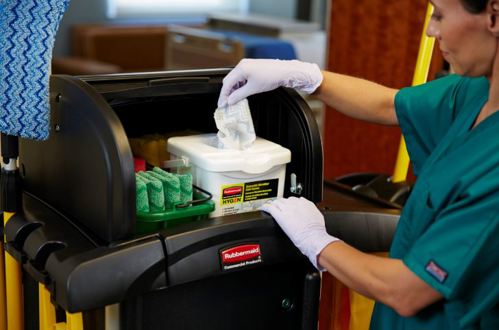
The average virus has a diameter of between 20 and 400 nanometres, making it difficult to see even under a microscope. Miniscule pathogens such as the novel coronavirus can have a devastating effect on individual and community health. Cleaning equipment like disposable microfibre cloths are useful tools in the fight against infectious diseases. What makes disposable microfibre the preferred choice of the healthcare industry? Keep reading to learn more.
Definitions: What is a microbe? What is a pathogen?
You might see the words pathogen and microbe used interchangeably, so it's important to understand what these terms really mean:
Pathogens can lead to an infection, which is when a dangerous microbe enters the body and multiplies, potentially leading to a disease. In the case of a virus, microbes enter the body and reproduce through a five-step process:
How microbes spread disease
Pathogenic microbes spread disease from person to person and, in the case of COVID-19, from animal to person. While some microbes can be airborne, others are transmitted through vector contact. That means a live carrier interacts with another person and viral particles get transmitted through bodily fluids. That can include invisible water vapour released during speech. Microbes may also spread through a vehicle -- an inanimate object such as a contaminated surface or surgical instrument. This method of transmission has been a major concern for businesses. For example, if a person speaks and releases small droplets of saliva onto a surface and another person touches that surface and then touches his or her face, that person could become infected.
How infections spread in healthcare environments
According to the Australian Commission on Safety and Quality in Healthcare, 180,000 patients per year contract healthcare associated infections (HAIs) that prolong their stay in the hospital. These infections lead to a preventable 2 million extra bed days. Research published by the U.S. National Center for Biotechnology Information indicates that the most common sources of HAIs are patients, medical equipment, healthcare personnel and environmental surfaces. Eliminating pathogenic microbes wherever possible is essential for reducing the risk of infectious disease. Newly developed deep cleaning procedures attempt to reduce this risk by carefully cleaning high-touch surfaces and protecting staff from unnecessary exposure to microbes.
Why microfibre cloths are better than traditional fabrics
Compared to traditional cotton cloths, microfibre is made from very fine synthetic filaments. This means that microfibre is much better at capturing and removing microbes from surfaces. Cotton isn't very good at removing microscopic debris. Cotton cloths push microbes around on surfaces, but do little else. What's worse is that cotton cloths can retain larger pathogens and actually spread them from one surface to another, increasing the chances of infection. Microfibre, on the other hand, is extremely absorbent, allowing it to remove microbes completely.
How Rubbermaid HYGEN™ Disposable Microfibre cloths set a higher standard
HYGEN™ Disposable Microfibre represents the highest standard of cleanliness. These products are proven to remove 99.9% of tested viruses and bacteria. While other cloths sprayed with cleaning solution may kill microbes, they don't remove them. That essentially leaves the dead microbes on surfaces where they serve as food for other pathogens. In a hospital setting, this could lead to a higher rate of infection. HYGEN™ Disposable Microfibre cloths scrub away dirt and absorb pathogens without smearing or streaking surfaces. Designed for use on tables, walls, floors and other surfaces, cleaning staff can effectively remove microbes from the most commonly touched areas of indoor environments. As Australia and the world continue to manage the COVID-19 pandemic, efforts to improve the standard of cleanliness will be extremely important. To learn more about how Rubbermaid Commercial Products support these efforts, check out our catalogue.